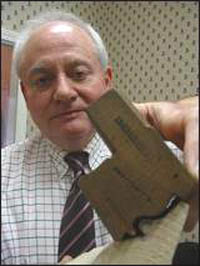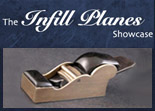eBay Planes Linked To Thomas Jefferson?
 A Lexington dentist and collector of old woodworking tools believes he has stumbled upon hand planes that may have been used at Thomas Jefferson’s Monticello.
A Lexington dentist and collector of old woodworking tools believes he has stumbled upon hand planes that may have been used at Thomas Jefferson’s Monticello.
The collector, Dr. Gary Coleman, could not believe it when he saw the names stamped on two antique woodworking planes offered on eBay.
Mr Coleman said “After looking at the pictures I could tell that the planes were from the right era. The name stamped on them was ‘J. Hemings’, which I thought could be John Hemings. I didn’t know at that time that one of the planes exactly matched a molding in Jefferson’s home.”
John Hemings was a master craftsman in wood. He started his working life in the carpentry and joinery workshop in 1793, when he was 17. It is understood that Hemings played a significant role in creating much of the woodwork for the restoration and expansion of Monticello between 1796 and 1809, and he is also credited with making Jefferson’s coffin. In 1826 John Hemings was freed and died less than a decade later in 1833. His sister was Sally Hemings – a reputed slave misstress of Jefferson.
Coleman reportedly bought both planes for about $100. The seller was in Pasedina, Calif., who had previously bought the planes from a dealer at a roadside market who knew nothing of their history.
The conservator of architecture and furniture at Monticello, Robert Self, said “It’s almost impossible to authenticate the planes because so little is known about them. The home no longer has any of the original woodworking planes and as far as I know there are no planes that are contributed to John Hemings.” He also stressed the importance of Hemings as a woodworker for the home “He became a very skilled craftsman here and Jefferson left Hemings many of Monticello’s woodworking tools in his will.”
Self, who has examined the Coleman planes, also stated “It’s interesting, there’s no doubt about it. One plane – the sash molder – does duplicate the molding profile here really quite exactly.”
A Connecticut architect Thomas L. Elliott, who is himself an authority on antique planes, has said “The first plane would be from the period of restoration of Monticello – from around 1790 to 1800. The second one is a later plane from about 1820 or thereabouts. That would put it after the renovation – the reflective period of time which John Hemings would have been working. The imprint is also appropriate for that period and I don’t believe that the stamps are forgeries.”
It is hoped that someone might come forward with more information now that the planes have received some publicity.
“If there are these two planes marked ‘J. Hemings,’ there may be others out there,” Self said. “A little bit of publicity might bring others out of the woodwork.”






